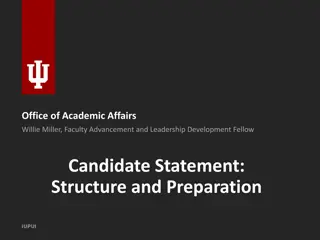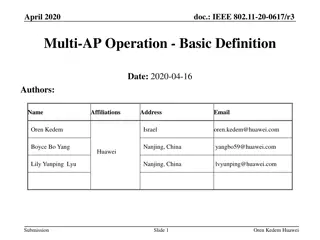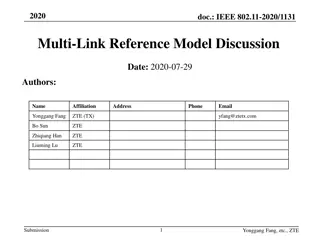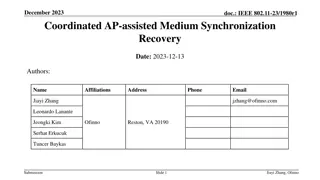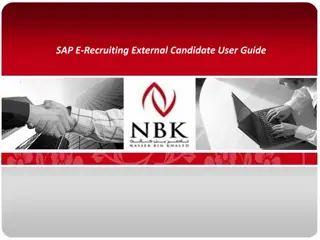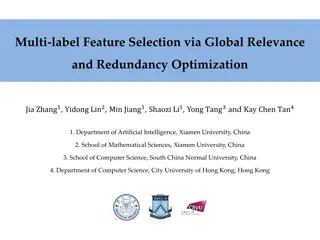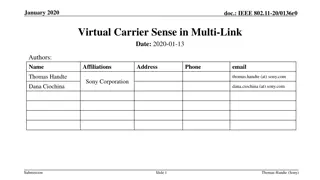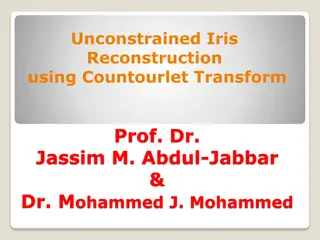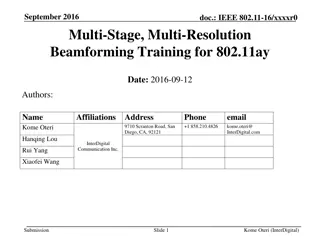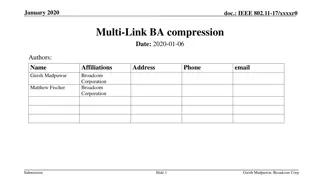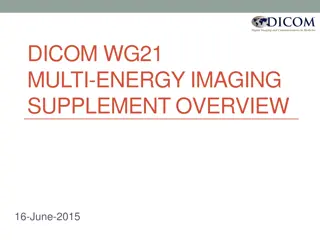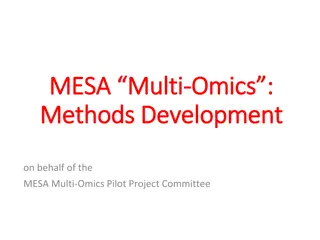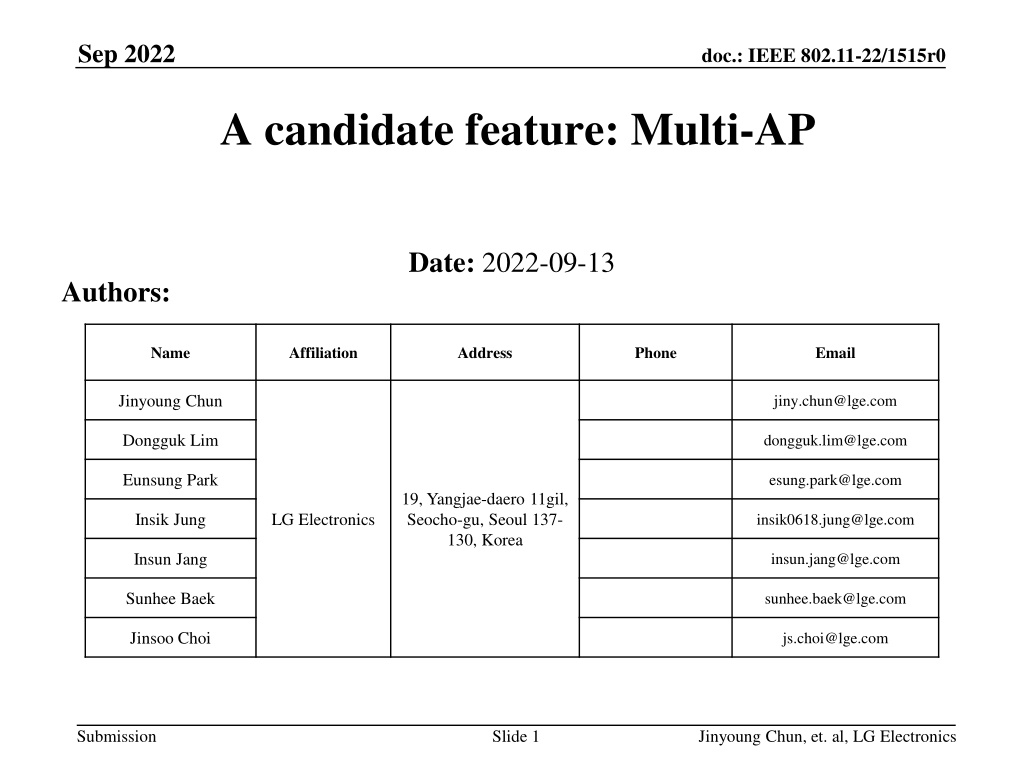
Improving WLAN Connectivity with Multi-AP Techniques
Explore the necessity and feasibility of multi-AP schemes to enhance WLAN reliability, reduce interference, and coordinate device connectivity. Learn about the potential benefits of implementing PHY/MAC techniques in IEEE standards for efficient signal transmission.
Download Presentation

Please find below an Image/Link to download the presentation.
The content on the website is provided AS IS for your information and personal use only. It may not be sold, licensed, or shared on other websites without obtaining consent from the author. Download presentation by click this link. If you encounter any issues during the download, it is possible that the publisher has removed the file from their server.
E N D
Presentation Transcript
Sep 2022 doc.: IEEE 802.11-22/1515r0 A candidate feature: Multi-AP Date: 2022-09-13 Authors: Name Affiliation Address Phone Email Jinyoung Chun jiny.chun@lge.com Dongguk Lim dongguk.lim@lge.com Eunsung Park esung.park@lge.com 19, Yangjae-daero 11gil, Seocho-gu, Seoul 137- 130, Korea Insik Jung LG Electronics insik0618.jung@lge.com Insun Jang insun.jang@lge.com Sunhee Baek sunhee.baek@lge.com Jinsoo Choi js.choi@lge.com Submission Slide 1 Jinyoung Chun, et. al, LG Electronics
Sep 2022 doc.: IEEE 802.11-22/1515r0 Introduction In the last plenary session, UHR SG is formatted. The Study Group will investigate technology which may improve reliability of WLAN connectivity, reduce latencies, increase manageability, increase throughput including at different SNR levels, and reduce device level power consumption [1]. In this document, we ll introduce the necessity, check the feasibility of multi-AP schemes as one candidate feature for improving reliability of WLAN connectivity, and find out the PHY/MAC techniques to be developed. Submission Slide 2 Jinyoung Chun, et. al, LG Electronics
Sep 2022 doc.: IEEE 802.11-22/1515r0 Needs of Multi-AP in IEEE (1/2) At Home, an AP is not enough to support signaling in the whole rooms due to obstacles like wall. So we can set several APs but it makes conflict signaling between APs. For this reason, multi-AP schemes can be a good solution. WAN Easy Mesh from WFA(originally named by Multi-AP) is already used but it s focused on AP selection without PHY and MAC change. In IEEE, we can make multi-AP techniques by enhancing PHY and MAC features for coordination and sharing in frequency, time, and spatial domain (e.g. RU selection, Joint transmission, or Nulling). Multi-AP Device 1 Multi-AP Controller Multi-AP Agent Logical Ethernet Port Fronthaul AP Logical Ethernet Port Non-AP STA 1 Backhaul STA Multi-AP Agent Multi-AP Agent Fronthaul AP Fronthaul AP Multi-AP Device 2 Multi-AP Device 3 Backhaul STA Non-AP STA 3 Multi-AP Agent Non-AP STA 2 Fronthaul AP Wi-Fi Backhaul Link Multi-AP Device 4 Wired Backhaul Link Non-AP STA 4 Wi-Fi Fronthaul Link < Easy Mesh deployment example > refer to Wi-Fi_EasyMesh_Specification_DRAFT_R5) Submission Slide 3 Jinyoung Chun, et. al, LG Electronics
Sep 2022 doc.: IEEE 802.11-22/1515r0 Needs of Multi-AP in IEEE (2/2) An use case We can consider Home Appliances like TV, refrigerator that equips Wi-Fi connectivity. Currently, home appliances operate as one of WiFi device like Smart Home IoT Service. In the future, the home appliances can be used as Shared AP connected with Sharing AP by using IEEE WiFi Multi-AP techniques. Some of devices can get signals jointly from Sharing AP and Shared AP, and some can get signals from an AP avoiding other AP s interference. Shared AP weak Sharing AP AP weak Shared AP < An example of a AP deployment > < An example of Multi-AP deployment > Submission Slide 4 Jinyoung Chun, et. al, LG Electronics
Sep 2022 doc.: IEEE 802.11-22/1515r0 Multi-AP techniques (1/2) Many multi-AP schemes were introduced from EHT TIG/SG to 11be TG [2-15] and can be categorized as below: Coordinated Transmission (C-TX) APs transmit data signals by splitting the spectrum (Coordinated OFDMA), by coordinating the spatial resource (Coordinated SR), by limiting interference from other APs (Coordinated Beamforming/Nulling), selectively(AP selection), etc. The techniques can be used jointly. Information sharing and scheduling between APs are needed. It helps improving the reliability of WLAN connectivity and reducing the latency. Submission Slide 5 Jinyoung Chun, et. al, LG Electronics
Sep 2022 doc.: IEEE 802.11-22/1515r0 Multi-AP techniques (2/2) Joint Transmission (J-TX) APs transmit data signals jointly. to a STA simultaneously (Joint Beamforming) to multiple STAs simultaneously (Joint MU-MIMO) Not only Information sharing and scheduling (like C-TX) but also Data sharing between APs are needed. It helps improving the reliability of WLAN connectivity and increasing edge user throughput. < An example of Coordinated beamforming/nulling > < An example of Joint MU-MIMO > Submission Slide 6 Jinyoung Chun, et. al, LG Electronics
Sep 2022 doc.: IEEE 802.11-22/1515r0 The performance and the overhead of Multi-AP techniques The performance of Multi-AP techniques Generally, C-TX has better performance than S-TX(single transmission), and J-TX has better performance than C-TX. [7] said, comparing with EDCA and SR, Coordinated SR has about 20~40% throughput gain when the number of Shared APs is more than 1 in both of Downlink and Uplink. [11] said, in the interference limited region, C-TX has a better performance than S-TX (single transmission) but its performance couldn t reach that of J-TX. And in the noise limited region, S-TX offers a good performance but it is hard to always guarantee a low interference level favorable to S-TX especially in a dense environment. The overhead of Multi-AP techniques Multi-AP operation can bring some overhead Wireless backhaul (AP-to-AP) negotiation signaling for information sharing between APs Channel status report of OBSS AP In addition, J-TX needs more overhead like [12] Wireless backhaul (AP-to-AP) data sharing for transmitting jointly OBSS NDP sounding for making beamforming matrix jointly Submission Slide 7 Jinyoung Chun, et. al, LG Electronics
Sep 2022 doc.: IEEE 802.11-22/1515r0 The required PHY/MAC features (1/4) For preparing Multi-AP operation, Sharing AP has to know shared APs status. AP s status means Multi-AP capabilities, channel status, buffer status of Shared APs and STAs operated in the Shared AP, etc. It can be done for sharing AP by overhearing the enhanced management frame or by requesting the information directly (e.g. defining new trigger frame to trigger OBSS APs reporting) to shared APs. AP selection and re-selection procedure is needed [14]. Sharing AP and shared APs have to be selected based on the above information. And Sharing AP needs to recognize whether the selected Shared APs can participate. Sharing AP Shared AP1 Shared AP2 Shared AP3 Submission Slide 8 Jinyoung Chun, et. al, LG Electronics
Sep 2022 doc.: IEEE 802.11-22/1515r0 The required PHY/MAC features (2/4) OBSS channel status report or OBSS NDP sounding are needed. For Multi-AP operation, STAs have to report OBSS AP s channel status. It can be done by listening on-going packet of OBSS AP or by doing NDP sounding with OBSS AP. Especially for J-TX, joint NDP sounding between sharing AP and shared APs shall be needed. And the details are also related to the maximum number of total spatial stream allowed for Multi-AP operation, and an example of procedure is as below [13]. Sharing AP Shared AP1 Shared AP2 Wireless backhaul data sharing is needed. APs have to share data transmitted to STA(s) each other. It s for J-TX only. Submission Slide 9 Jinyoung Chun, et. al, LG Electronics
Sep 2022 doc.: IEEE 802.11-22/1515r0 The required PHY/MAC features (3/4) For transmitting Multi-AP data, Sharing AP triggers Multi-AP operation to shared APs. New Multi-AP trigger frame can be defined [15] with the information including: Multi-AP types like C-OFDMA, C-SR, Joint Beamforming, etc Participated Shared APs information and STAs information Operation and allocation method like, for example, channel/RU allocation for C- OFDMA*, SR information for C-SR**, beamforming matrix information for J- TX***. It can be differed by Multi-AP types. * The minimum allocation unit per APs has to be defined for C-OFDMA operation. ** It needs to study which combination of DL/UL of Sharing AP/Shared AP are allowed/possible [10]. *** The maximum number of total spatial streams of APs shall be defined. New beamforming matrix design can be needed for supporting over 8 streams. Submission Slide 10 Jinyoung Chun, et. al, LG Electronics
Sep 2022 doc.: IEEE 802.11-22/1515r0 The required PHY/MAC features (4/4) And the Shared APs/Sharing AP transmit data to each STA(s). New PPDU format may be needed including preamble design. For example of DL C-OFDMA, the data can be transmitted with joint preamble or discrete preamble. PPDU format with joint preamble: U-SIG can be transmitted identically with the same information including all information of Sharing AP and Shared APs through whole bandwidth. PPDU format with discrete preamble: U-SIG can be transmitted with own AP s information in own allocated bandwidth. * STF/LTF design can be changed depending on the PPDU format. And 2nd method may be studied with primary channel rule. For example of Joint Beamforming, shared APs can transmit data like UL MU-MIMO in 11be. (but it s transmitted from shared AP, not from STA like in 11be). frequency DL Data to STA1 MAP Trigger Sharing AP DL Data to STA2 Shared AP Ack to Sharing AP STA1 Ack to Shared AP STA2 time < An example of data transmission procedure of DL C-OFDMA > Submission Slide 11 Jinyoung Chun, et. al, LG Electronics
Sep 2022 doc.: IEEE 802.11-22/1515r0 Summary We reviewed Multi-AP techniques and studied the performance, overhead and required PHY/MAC changes. Multi-AP techniques have better performance than S-TX generally and we can consider Multi-AP as one of candidate features in UHR SG to help improving reliability of WLAN connectivity. But Multi-AP techniques also have more overhead. Especially J-TX needs data sharing between APs and OBSS NDP sounding, etc. Therefore we need to check the feasibility and the benefit carefully. Submission Slide 12 Jinyoung Chun, et. al, LG Electronics
Sep 2022 doc.: IEEE 802.11-22/1515r0 Reference [1] 11-22/0708r3, Beyond be Proposed Next Step , Rolf de Vegt [2] 11-20/1934r66, Compendium of straw polls and potential changes to the Specification Framework Document , Edward Au [3] 11-18/1926r2, Terminology for AP Coordination , Sameer Vermani [4] 11-18/1576r1, Considerations on AP Coordination , Yang Bo, Roger Marks, Lyu Yunping, Yuchen Guo [5] 11-18/1547r0, Technology Features for 802.11 EHT , Kome Oteri [6] 11-19/0638r0, Nulling and coordinated beamforming , Sigurd Schelstraete [7] 11-19/0801r0, AP Coordination in EHT , Jason Yuchen Guo [8] 11-19/1594r2, Coordinated Beamforming/Null Steering Protocol in 802.11be, David Lopez-Perez [9] 11-20/410r0, Coordinated Spatial Reuse Procedure , Sungjin Park [10] 11-20/1040r0, Coordinated SR for Uplink , Jonghun Han [11] 11-19/0779r1, Performance Investigation on Multi-AP Transmission , Eunsung Park [12] 11-19/1089r0, Joint Transmissions: Backhaul and Gain State Issues , Sameer Vermani [13] 11-19/1895r2, Setup for Multi-AP coordination , Sungjin Park [14] 11-19/1143r3, Efficient Operation for Multi-AP Coordination , Sungjin Park [15] 11-20/0560r0, Multi-AP Configuration and Resource Allocation , Po-Kai Huang Submission Slide 13 Jinyoung Chun, et. al, LG Electronics

